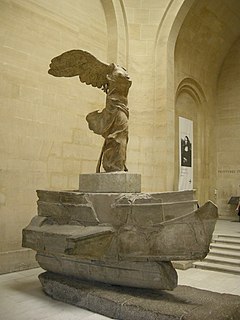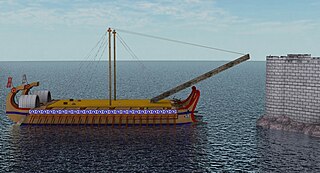 W
WA bireme is an ancient oared warship (galley) with two decks of oars. Biremes were long vessels built for military purposes and could achieve relatively high speed. They were invented well before the 6th century BC and were used by the Phoenicians, Assyrians, and Greeks.
 W
WClasse was a commercial port located 4 km (2.5 mi) east south east from Ravenna, Italy. It was near the head of the Adriatic coast. For almost five hundred years it was an important strategic military port. When it was not being used as a military port, it was an important commercial port for the imperial capital of Ravenna in the Roman Empire. Classe comes from the Latin word classis, meaning fleet.
 W
WThe Classis Germanica was a Roman fleet in Germania Superior and Germania Inferior. Besides the Channel Fleet, it was one of the largest naval forces of the Roman Empire, ranking above all other provincial fleets.
 W
WThe corvus was a Roman naval boarding device used in sea battles against Carthage during the First Punic War.
 W
WThe harpax or harpago was a Roman catapult-shot grapnel created by Marcus Vipsanius Agrippa for use against Sextus Pompey during the naval battles of the Sicilian revolt.
 W
WFrom the 4th century BC on, new types of oared warships appeared in the Mediterranean Sea, superseding the trireme and transforming naval warfare. Ships became increasingly large and heavy, including some of the largest wooden ships hitherto constructed. These developments were spearheaded in the Hellenistic Near East, but also to a large extent shared by the naval powers of the Western Mediterranean, specifically Carthage and the Roman Republic. While the wealthy successor kingdoms in the East built huge warships ("polyremes"), Carthage and Rome, in the intense naval antagonism during the Punic Wars, relied mostly on medium-sized vessels. At the same time, smaller naval powers employed an array of small and fast craft, which were also used by the ubiquitous pirates. Following the establishment of complete Roman hegemony in the Mediterranean after the Battle of Actium, the nascent Roman Empire faced no major naval threats. In the 1st century AD, the larger warships were retained only as flagships and were gradually supplanted by the light liburnians until, by Late Antiquity, the knowledge of their construction had been lost.
 W
WIsidore of Chios was a faithful Christian who was martyred on the island of Chios in 251 under the persecutions ordered by the Roman emperor Decius. His feast day is commemorated on May 14.
 W
WIvlia (bireme) is a modern reconstruction of an ancient Greek rowing warship (galley) with oars at two levels and an example of experimental archaeology. Between 1989 and 1994, this vessel undertook six international historical and geographical expeditions in the footsteps of the ancient seafarers.
 W
WThe Museum of Ancient Seafaring was installed in Mainz in 1994 in the former central covered market near the South Station, nowadays Mainz Römisches Theater station, as a branch of the Romano-Germanic Central Museum (Mainz). The new archaeological center is built right beside the current museum building. A workshop is affiliated to the museum, where visitors have the opportunity to watch the staff replicate ancient ship models.
 W
WNavis actuaria was a type of transport ship used by the Roman navy.
 W
WA navis lusoria is a type of a small military vessel of the late Roman Empire that served as a troop transport. It was powered by about thirty soldier-oarsmen and an auxiliary sail. Nimble, graceful, and of shallow draft, such a vessel was used on northern rivers close to the Limes Germanicus, the Germanic border, and thus saw service on the Rhine and the Danube. The Roman historian Ammianus Marcellinus mentioned the navis lusoria in his writings, but not much about it could be learned until the discovery of such boats at Mainz, Germany in 1981–82.
 W
WThe Port of Mainz is the port of Mainz, Germany. Lying on the western bank of the Rhine river, it has a long history reaching back through the Middle Ages to Roman times. The modern port facilities, existing for approximately 120 years in their general environs, are located mostly to the north of the city proper, and will be extended to the north of their current location during the coming years to make space for a new residential area.
 W
WThe Roman shipyard of Stifone is an archaeological find of Roman origin recently discovered in Umbria, in the municipality of Narni, inside an artificial channel adjacent the Nera River, about 900 metres down-river from the village of Stifone. Its position is just behind the remains of the river port of the ancient city of Narni.
 W
WThe sambuca was a ship-borne siege engine which was invented by Heracleides of Tarentum and was first used unsuccessfully by Marcus Claudius Marcellus during the Roman siege of Syracuse in 213 BC.
 W
WA trireme was an ancient vessel and a type of galley that was used by the ancient maritime civilizations of the Mediterranean, especially the Phoenicians, ancient Greeks and Romans.